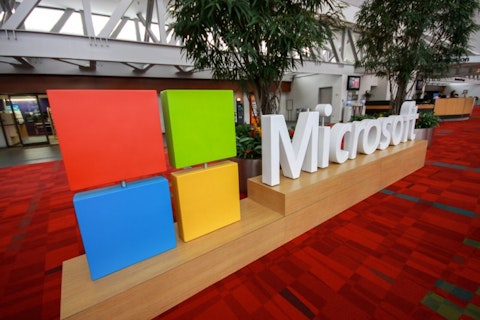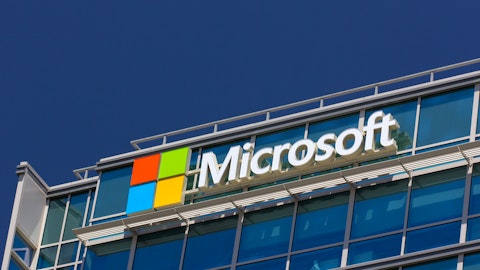Microsoft Corporation (NASDAQ:MSFT) released its financial results for its fiscal fourth quarter in the after-hours on Tuesday. Shares dropped by around 4% following the announcement, despite the fact that the company managed to beat the analysts’ expectations marginally on both earnings and revenues. Earlier this month, Microsoft Corporation, which is one of the biggest software companies in the World, wrote-down $7.6 billion relating to the Nokia acquisition. Including this, Microsoft posted a loss of $0.40 per share. Excluding the Nokia write-down, the company posted adjusted earnings of $0.62 per share. Microsoft posted total revenue of $22.2 billion for the quarter with an operating loss of around $2.05 billion. The Windows OS maker managed to beat the Street’s expectations of $0.56 in EPS and $22 billion in revenues. Microsoft shares bounced back from the drop in the pre-market in the early trading hours on Wednesday, but closed yesterday down by 3.68%.

drserg / Shutterstock.com
Despite the earnings beat, why did the shares drop on Wednesday? The main reason behind the drop is the steady decline of some of its core businesses. The Windows business has continued its steady decline in the fiscal fourth quarter. Revenue from the Windows business was down by 22% year-over-year during the quarter. Microsoft claimed that this decline was due to the upcoming launch of Windows 10. Microsoft’s phone business revenue also dropped by a whopping 68%, but the phone business is not as bad as it sounds, considering the fact that Microsoft realized $382 million from the end of its phone agreement with Nokia during the same period a year ago. In reality Microsoft has sold 10% more Lumia phones than a year ago. The next important factor is the slowing growth of its cloud business, as many recognize that Microsoft’s future depends on the cloud rather than the well-known OS business. Taking into account that Microsoft’s cloud business grew by 106%, 114% and 128% in the last three quarters respectively, 88% growth during the fiscal fourth quarter is a concern for many investors. Microsoft’s Office business also moved downhill during the quarter.
On the positive side, Microsoft’s Surface-related business revenue witnessed a year-over-year growth of 117% during the fourth quarter, generating $888 million for the quarter and $3.6 billion for fiscal year 2015, 65% more than the revenue generated in FY2014. But in comparison with Apple Inc. (NASDAQ:AAPL)’s Mac and iPad business generating more than $5 billion each in the last quarter, it’s a clear indication that Microsoft is miles behind Apple in this sector. The Xbox business also witnessed a modest growth in the fourth quarter, as the company sold 1.4 million Xbox consoles, 30% more than a year ago, but revenues grew just 10% as Microsoft decided to cut their margins on the hardware in order to increase sales. Microsoft’s search engine, Bing, also witnessed an increase in market share during the quarter, up to 20.3% of the market share in the U.S, and search engine revenues also grew by 21% during the quarter.
Microsoft Corporation (NASDAQ:MSFT) was a very popular stock among hedge funds, as there were 110 hedge funds with around $16.13 billion invested in the stock by the end of March, down from $17.87 billion ion shares held at the end of 2014. Considering the fact that Microsoft’s stock lost more than 13% of its value during the January – March period however, the hedge funds opted to put more money into the stock during the first three months of the year, and were rewarded with a big rebound in the second quarter.
We don’t just track the latest moves of funds. We are, in fact, more interested in their 13F filings, which we use to determine the top 15 small-cap stocks held by the funds we track. We gather and share this information based on 16 years of research, with backtests for the period between 1999 and 2012 and forward testing for the last 2.5 years. The results of our analysis show that these 15 most popular small-cap picks have a great potential to outperform the market, beating the S&P 500 Total Return Index by nearly one percentage point per month in backtests. Moreover, since the beginning of forward testing in August 2012, the strategy worked brilliantly, outperforming the market every year and returning 139%, which is more than 80 percentage points higher than the returns of the S&P 500 ETF (SPY) (see more details).





